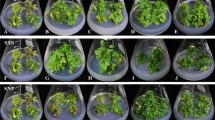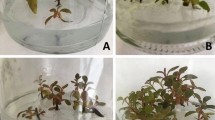Abstract
Ethylene accumulation in four different rose in vitro culture containers was evaluated. Multiplication rate was the highest, and axes most elongated, in the two containers where ethylene accumulation was limited. Pulse treatments of ethylene at various concentrations enhanced proliferation depending on concentration (5 ppm generally was the most favourable) and time of application, while reducing elongation of the shoots. An ethylene trap in the flask atmospheres of the cultures reduced rose shoot proliferation rate but increased elongation of the axes. Inhibitors of ethylene biosynthesis, aminoethoxyvinylglycine (AVG) and cobalt chloride (CoCl2), increased multiplication rate by providing a higher number of axes of a suitable size for subculture. The ethylene precursor 1-aminocyclopropane-1-carboxylic acid (ACC) had a beneficial effect on multiplication rate, although reducing longitudinal growth of the axes.
Similar content being viewed by others
Abbreviations
- ACC:
-
1-aminocyclopropane-1-carboxylic acid
- AVG:
-
aminoethoxyvinylglycine
- BA:
-
benzyladenine
- GA3 :
-
gibberellic acid
- IBA:
-
indolyl-3-butyric acid
References
Abeles FB (1973) Ethylene in Plant Biology (p 302) Academic Press, New York
Cheverry JL, Sy MO, Pouliqueen J & Marcellin P (1988) Regulation by CO2 of 1-aminocyclopropane-1-carboxylic acid and conversion to ethylene in climacteric fruits. Physiol, Plant, 72: 535–540
Cornejo-Martin MJ, Mingo-Castel AM & Primo-Millo E (1979) Organ redifferentiation in rice callus: effects of C2H4, CO2 and cytokinins. Z. Pflanzenphysiol 94: 117–123
De Proft MP, Maene LJ & Debergh PC (1985) Carbon dioxide and ethylene evolution in the culture atmosphere of Magnolia cultured in vitro. Physiol. Plant. 65: 375–379
Gaspar Th (1988) Multiplication végétative des plantes supèrieures par culture in vitro. In: Zryd JP (Ed) Cultures de Cellules, Tissus et Organes Végétaux. Fondements Théoriques et Utilisations Pratiques (pp 31–50). Presses Polytech Romandes, Lausanne
Gaspar Th, Kevers C, Bouillenne H, Mazière Y & Barbe JP (1989) Ethylene production in relation to rose micropropagation through axillary budding. In: Clijsters M, De Proft M, Marcelle R & Van Poucke M (Eds) Biochemical and Physiological Aspects of Ethylene Production in Lower and Higher Plants (pp 303–312). Kluwer Acad Publ, Dordrecht
Gavinlertvatana P, Read PE, Wilkins HF & Hens R (1982) Ethylene levels in flask atmospheres of Dahlia pinnata Cav. leaf segments and callus cultures in vitro. J. Amer. Soc. Hort. Sci. 107: 3–6
George EF & Sherrington PD (1984) Plant Propagation by Tissue Culture (p 709). Exegetics Limited, Eversley
Halevy AH (1986) Recent advances in the use of growth substances in ornamental horticulture. In: Bopp M (Ed) Plant Growth Substances 1985 (pp 391–398). Springer Verlag, Berlin
Hillman JR (1986) Apical dominance and correlations by hormones. In: Bopp M (Ed) Plant Growth Substances 1985 (pp 341–349). Springer-Verlag, Berlin
Huxter TJ, Thorpe TA & Reid DM (1981) Shoot initiation in light- and dark-grown tobacco callus: the role of ethylene. Physiol. Plant. 53: 319–326
Jackson MB, Abbott AJ, Belcher AR & Hall KC (1987) Gas exchange in plant tissue cultures. In: Jackson MB, Mantell SH & Black J (Eds) Advances in the Chemical Manipulation of Plant Tissue Cultures. Monograph 16 (pp 57–71). British Plant Growth Regulator Group, Bristol
Jona R, Gribaudo R & Vigliocco R (1987) Natural development of ethylene in air tight vessels of GF 677. In: Ducoté G, Jacob M & Siméon A (Eds) Plant Micropropagation in Horticultural Industries (pp 61–66). Presses Universitaires, Liège
Kévers C & Gaspar Th (1985) Vitrification of carnation in vitro: changes in ethylene production, ACC level and capacity to convert ACC to ethylene. Plant Cell Tiss. Org. Cult. 4: 215–223
Kumar PP & Thorpe TA (1989) Alteration of growth and morphogenesis by endogenous ethylene and carbon dioxide in conifer tissue cultures. In: Dhawan V (Ed) Applications of Biotechnology in Forestry and Horticulture (pp 205–214). Plenum Pres, New York
Martin C, Carré M & Vernoy R (1981) La multiplication végétative in vitro des végétaux ligneux cultivés: cas des Rosiers. Compt Rend Acad Sci Paris Sér III 293: 175–177
McClelland MT & Smith MAL (1990) Vessel type, closure, and explant orientation influence in vitro performance of five woody species. HortScience 24: 797–800
Mekers O, Meiresonne L & Meneve I (1984) Ethylene production inhibitors can improve in vitro propagation of roses. Med. Fac. Landbouww Rijksuniv Gent 49/3b: 1139–1144
Murashige T & Skoog F (1962) A revised medium for rapid growth and bioassays with tobacco tissue cultures. Physiol. Plant. 15: 473–497
Righetti B, Magnanini E, Infante R & Predieri S (1990) Ethylene, ethanol, acetaldehyde and carbon dioxide released by Prunus avium shoot cultures. Physiol. Plant. 78: 507–510
Ringe F (1972) Förderung der Zellproliferation unter der Einwirkung von 2-Chloräthylphosphorsaüre bei Explantaten von Begonia x richmondensis in steriler Kultur. Z. Pfanzenphysiol. 67: 45–48
Robinson KEP, Adams DO (1987) The role of ethylene in the regeneration of Helianthus annuus (sunflower) plants from callus. Physiol Plant. 71: 151–156
Sisler EC, Wood C (1988) Interaction of ethylene and CO2. Physiol. Plant. 73: 440–444
Taylor GE & Gunderson CA (1988) Physiological site of ethylene effects on carbon dioxide assimilation in Glycine max L. Merr. Plant Physiol. 86: 85–92
Van Aartrijk J, Blom-Barnhoorn GJ & Bruinsma J (1986) A role for ethylene biosynthesis in adventitious bud formation on bulb-scale tissue of Lilium speciosum. In: Withers LA & Alderson PG (Eds) Plant Tissue Culture and its Agricultural Applications (pp 55–61). Butterworths, London
Van Dijck R, De Proft M & De Greef J (1988) Role of ethylene and cytokinins in the initiation of lateral shoot growth in bromeliads. Plant Physiol. 86: 836–840
Woltering EJ (1986) Ethylene and carbon dioxide accumulation within various tissue culture systems. Acta Bot. Neerl. 35: 50
Yeang HY & Hillman JR (1982) Lateral bud growth in Phaseolus vulgaris L. and the levels of ethylene in the bud and adjacent tissue. J. Exp. Bot. 33: 111–117
Author information
Authors and Affiliations
Rights and permissions
About this article
Cite this article
Kevers, C., Boyer, N., Courduroux, JC. et al. The influence of ethylene on proliferation and growth of rose shoot cultures. Plant Cell Tiss Organ Cult 28, 175–181 (1992). https://doi.org/10.1007/BF00055514
Received:
Accepted:
Issue Date:
DOI: https://doi.org/10.1007/BF00055514




